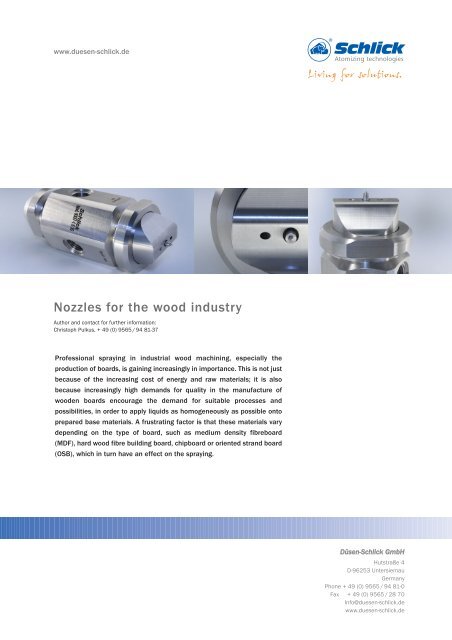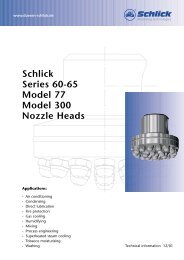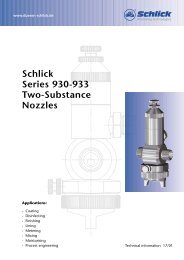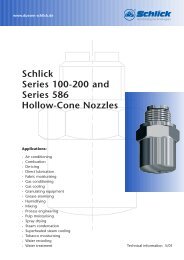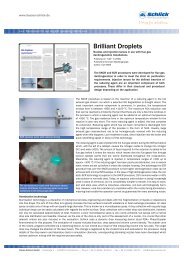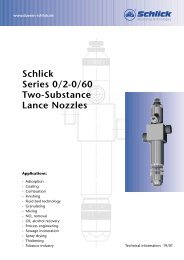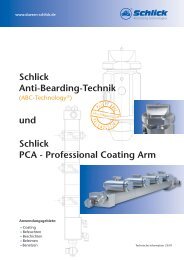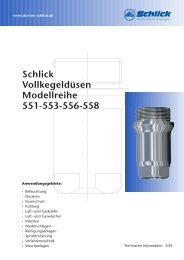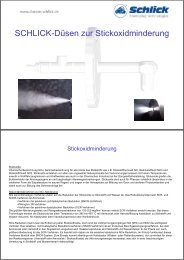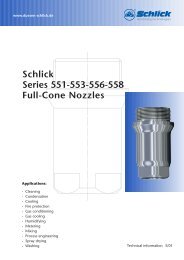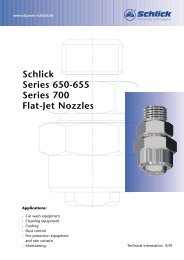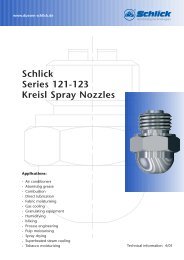further information - Düsen-Schlick GmbH
further information - Düsen-Schlick GmbH
further information - Düsen-Schlick GmbH
You also want an ePaper? Increase the reach of your titles
YUMPU automatically turns print PDFs into web optimized ePapers that Google loves.
www.duesen-schlick.deLiving for solutions.Nozzles for the wood industryAuthor and contact for <strong>further</strong> <strong>information</strong>:Christoph Pulkus, + 49 (0) 9565 / 94 81-37Professional spraying in industrial wood machining, especially theproduction of boards, is gaining increasingly in importance. This is not justbecause of the increasing cost of energy and raw materials; it is alsobecause increasingly high demands for quality in the manufacture ofwooden boards encourage the demand for suitable processes andpossibilities, in order to apply liquids as homogeneously as possible ontoprepared base materials. A frustrating factor is that these materials varydepending on the type of board, such as medium density fibreboard(MDF), hard wood fibre building board, chipboard or oriented strand board(OSB), which in turn have an effect on the spraying.Düsen-<strong>Schlick</strong> <strong>GmbH</strong>Hutstraße 4D-96253 UntersiemauGermanyPhone + 49 (0) 9565 / 94 81-0Fax + 49 (0) 9565 / 28 70Info@duesen-schlick.dewww.duesen-schlick.de
www.duesen-schlick.deLiving for solutions.However, the production of all these types ofboards is similar. The individual fibres orshavings are transported along a large conveyorline and sprayed and moistened with releaseagent, water or glue. Finally, the treated basematerial is pressed into boards.medium densityfibreboardGluing, humidifying, coating ...When manufacturing chipboard or MDF board, the gluing process is carriedout differently. While the application of glue to the shavings for chipboardtakes place in mixing drums, the fibres for MDF board are processed in ablowline (for wet gluing) or in a hopper (for dry gluing). The aim here is todistribute the glue in the blow pipe as homogeneously as possible, becausean uneven application of glue leads to staining on the fibreboard andtherefore a decrease in quality.As the shavings and fibres are transported along the conveyor lines tothe presses, they are moistened with specially designed nozzles or variousadditives are applied. Here, the flat jet nozzles are used almost exclusivelybecause of their spray features. These nozzles are used as pressure nozzles(single-substance nozzles) or two-substance nozzles. When twosubstancenozzles are used, a second substance (air or steam) is used as an auxiliaryatomisation medium.Modell 650/0(basic version)Modell 650/7-1(pneumatic control)Modell 650 Form 8(with electromagneticalopen/close control)The <strong>Schlick</strong> flat jet nozzle model 650 is usedin its various design forms as a pressurenozzle for industrial wood machining.Pressure nozzles or two-substance nozzles?Both nozzle systems offer different conditions, which must be consideredduring the production process: for example, the lower purchase price aswell as the low operational costs of pressure nozzles prove to be a financialadvantage, compared to those of two-substance nozzles. Other beneficialfactors of the pressure nozzle system are the maximum attainable atomisationangle of 120° and the small atomisation momentum due to the lowdrop speed. With this atomisation system, the achievable drop size isdirectly proportionally to the current liquid pressure difference: the higherthe pressure, the finer the spray. Experience shows that with pressurenozzles, drop sizes smaller than 100 micrometres (with flat jet nozzles) or50 micrometres (with hollow cone nozzles) cannot be achieved. However,problems with atomisation, even at high pressures, emerge with moreviscous media. With suspensions with a high solid content, pressurenozzles thus react sensitively in continuous operation. Furthermore, thecontrol range is limited by the laws of physics. For example, to double theflow rate of a nozzle, the liquid pressure must be quadrupled.In contrast to pressure nozzles,two-substance nozzles work with asecond medium, such as air orsteam, for example. In the externalmixversions both mediums can beregulated independently from eachother. The proportion of air or steamto liquid defines the drop size, andthis makes sizes of even 10 – 15micrometres feasible. The separatecontrol of the two media allows fora liquid control range of 1:8. Evenhighly viscous media can be atomisedhomogeneously with thistechnology without being susceptibleto blockages.+++ Company contact +++Düsen-<strong>Schlick</strong> <strong>GmbH</strong> . Hutstraße 4 . D-96253 Untersiemau . Phone + 49 (0) 9565 / 94 81-0 . Fax + 49 (0) 9565 / 28 70 . Info@duesen-schlick.de
www.duesen-schlick.deLiving for solutions.A solution with a twist: ABC technologyAnbackproblematik bei der herkömmlichen2-Stoff-Flachstrahldüsemit „Hörnerkappe“ ohne ABC-TechnikIn Düsen-<strong>Schlick</strong>'s product range,model series 930 for the two-substanceflat jet nozzle is conventionallydesigned: air cap with "horns" for theproduction of the flat jet. The experts at<strong>Schlick</strong> have developed an innovativesolution to the generally known problemof sticking and the related inhomogeneousspray pattern, caused by turbulencein the orifice, the "horns". Thetwo-substance flat jet nozzle model930 PRO ABC uses the new, patentedanti-bearding technology (ABC technology).2-Stoff-FlachstrahldüseModell 930 Pro ABC mitABC-Technik (Anti-Bearding-Technik), die Ablagerungenund Anbackungen an derDüsenmündung verhindertABC technology prevents debris build-up and sticking at the nozzle orificeby avoiding turbulence in the rounded air cap. In the productionprocess, the ABC system increases process reliability, avoids downtimesfor cleaning and coats surfaces evenly with a homogeneousspray pattern.Nozzles for oil lubricationSmooth jet nozzle from <strong>Schlick</strong>, model 629As in many other industrial fields, itis also important in the woodmachining industry to maintain sufficientand continual lubrication ofthe roller presses, due to the highloads. A smooth jet nozzle from<strong>Schlick</strong>, such as model 629, is suitablefor precise spraying. However,choosing the right nozzle alwaysdepends on a number of factors.Depending on the point of installationor on the atomisation medium,alternative nozzle systems such ashollow cone nozzles, as pressurevariants, or twosubstance nozzlescan be used for this application.Consulting experts in the field ofnozzle technology is always recommended.In the field of board production in industrial wood machining, fibremats are moistened with steam immediately before being pressed.Equally important for a high-quality product is that the fibres aresprayed at a suitable steam pressure and with the correct amount ofsteam. For industrial use, the Laval nozzle model 630 from <strong>Schlick</strong>can be used in this industry, as well as other nozzles.+++ Company contact +++Düsen-<strong>Schlick</strong> <strong>GmbH</strong> . Hutstraße 4 . D-96253 Untersiemau . Phone + 49 (0) 9565 / 94 81-0 . Fax + 49 (0) 9565 / 28 70 . Info@duesen-schlick.de


